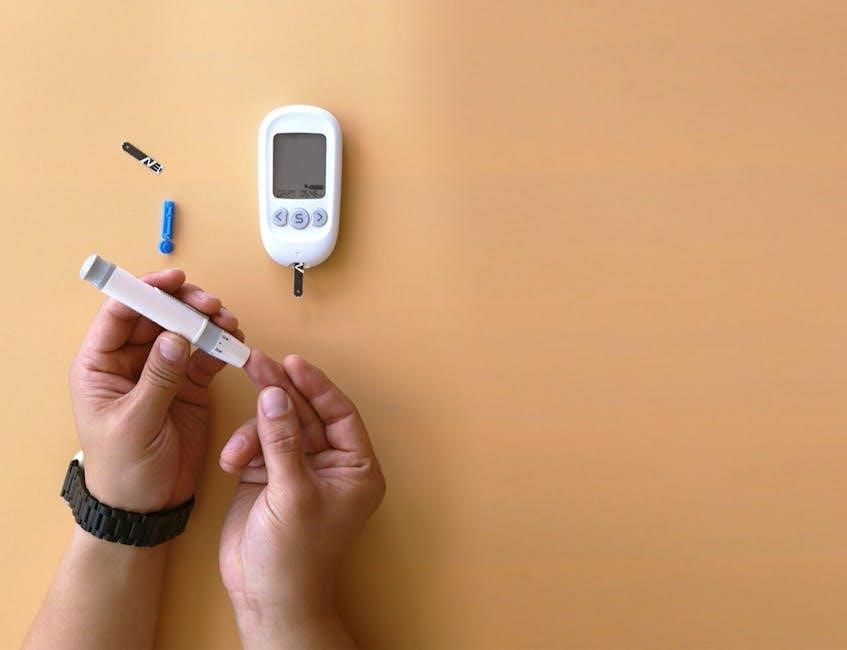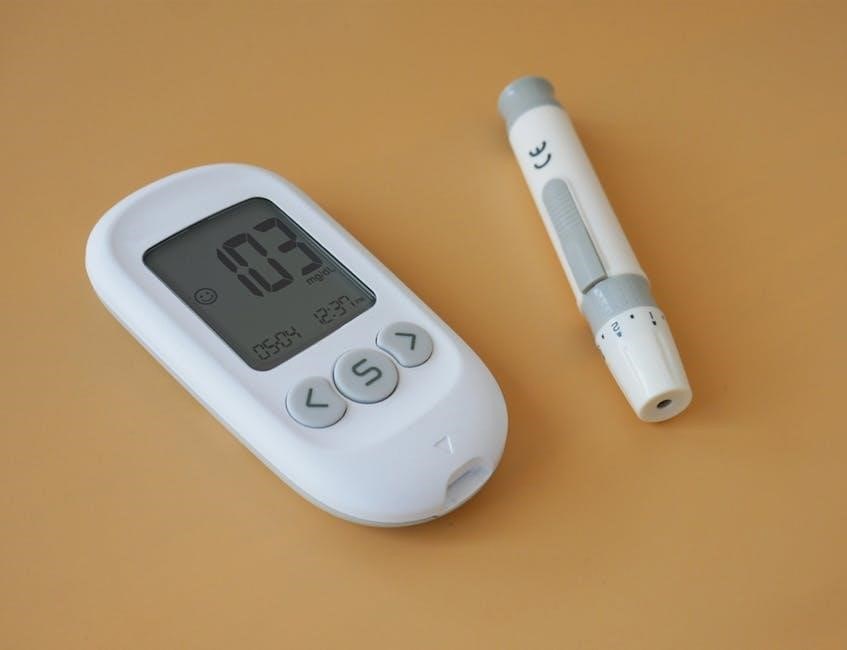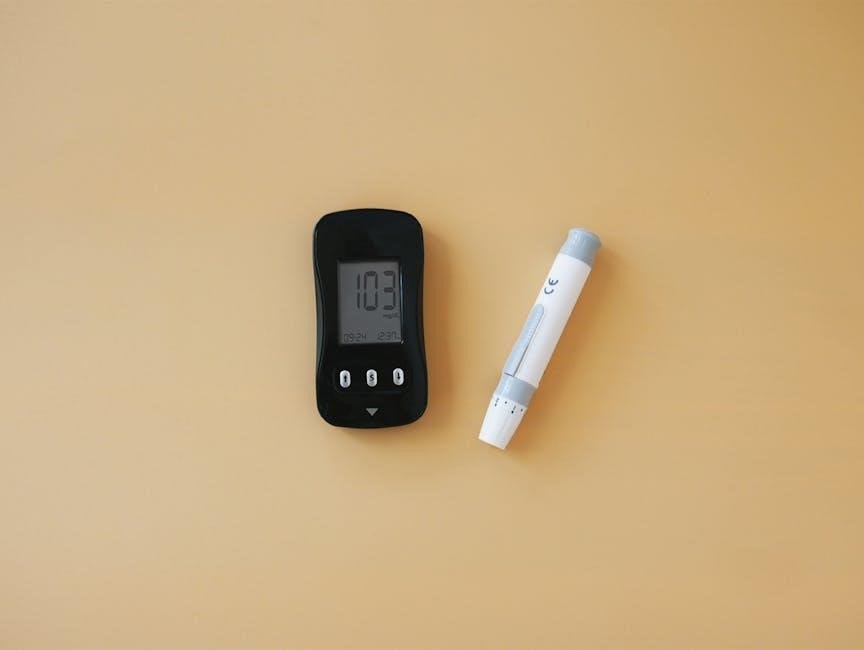The Asthma Control Test (ACT) is a validated questionnaire for individuals aged 12 and older to assess asthma control․ It helps identify symptom severity and treatment effectiveness, guiding asthma management plans․
What is the Asthma Control Test?
The Asthma Control Test (ACT) is a widely used, validated questionnaire designed to assess asthma control in individuals aged 12 years and older․ It consists of five questions that evaluate asthma symptoms, the frequency of rescue medication use, and the impact of asthma on daily activities․ The test provides a numerical score ranging from 5 to 25, with higher scores indicating better asthma control․ The ACT is a simple, patient-administered tool that helps healthcare providers determine whether asthma symptoms are well-managed or if adjustments to treatment are needed․ It is recognized by the National Institutes of Health (NIH) and has been clinically validated against specialist assessments, making it a reliable measure for asthma management․ The test is often used in clinical practice to monitor asthma over time and guide shared decision-making between patients and healthcare providers․
Why is the ACT important for asthma management?
The Asthma Control Test (ACT) plays a crucial role in asthma management by providing a standardized and reliable measure of asthma control․ Recognized by the National Institutes of Health (NIH), the ACT helps identify individuals with poorly controlled asthma who may benefit from treatment adjustments․ By assessing symptoms, rescue medication use, and daily activity impairment, the ACT offers insights into the effectiveness of current treatment plans․ This tool is particularly valuable for guiding clinical decisions, such as medication changes or lifestyle modifications․ Additionally, the ACT facilitates shared decision-making between patients and healthcare providers, empowering individuals to take an active role in managing their condition․ Regular use of the ACT can also monitor asthma control over time, ensuring timely interventions and improving long-term outcomes․ Its simplicity and effectiveness make it an essential component of comprehensive asthma care․

Development and Validation of the ACT
The Asthma Control Test was developed for individuals 12 and older, recognized by the NIH, and validated against specialist assessments with cross-sectional validation from studies by Liu et al․
History of the ACT and its creation
The Asthma Control Test (ACT) was developed as a tool to assess asthma control in individuals aged 12 and older․ Recognized by the National Institutes of Health (NIH) in its 2007 asthma guidelines, the ACT was created to provide a standardized method for evaluating asthma management․ Initially designed to help healthcare providers understand asthma control, the test has since become a widely used resource․ The ACT was validated through cross-sectional studies, ensuring its reliability in measuring symptom severity and treatment effectiveness․ Its development was driven by the need for a simple, patient-friendly questionnaire that could be easily integrated into clinical practice․ Over time, the ACT has evolved to remain a key tool in asthma management, aiding both patients and providers in making informed decisions about care․
Cross-sectional validation of the ACT
The Asthma Control Test (ACT) underwent rigorous cross-sectional validation to ensure its effectiveness in assessing asthma control․ Studies involving diverse patient populations demonstrated that the ACT accurately measures symptom severity and treatment outcomes․ This validation process compared ACT scores with specialist assessments, including spirometry, confirming its reliability․ The ACT’s ability to identify poorly controlled asthma was consistent across different demographic groups․ Its validation has been recognized in numerous clinical guidelines, further establishing its credibility as a diagnostic tool․ The cross-sectional validation process highlighted the ACT’s simplicity and effectiveness, making it a valuable resource for both healthcare providers and patients in managing asthma effectively․

How to Take the Asthma Control Test
The Asthma Control Test (ACT) is a simple, 5-item questionnaire for individuals aged 12 and older․ It assesses asthma symptoms over the past four weeks, with scores aiding treatment decisions․
Step-by-Step Guide to Completing the ACT
Receive the Test: Obtain the Asthma Control Test (ACT) from your healthcare provider or download it as a PDF for individuals aged 12 and older․
Answer Questions: Complete the 5-item questionnaire, reflecting on your asthma symptoms over the past 4 weeks․ Questions cover nighttime awakenings, symptom frequency, and activity limitations․
Score Each Item: Assign a score (1-5) to each answer, with higher numbers indicating better control․ Write the score in the provided box for each question․
Calculate Total Score: Sum the scores from all 5 questions․ The total score ranges from 5 to 25, with higher scores indicating better asthma control․
Review Results: Interpret your score using the provided scale․ A score of 19-25 indicates well-controlled asthma, while scores below 19 suggest uncontrolled symptoms․
Share with Provider: Bring the completed test to your healthcare provider to discuss results and adjust your treatment plan if needed․
This process ensures accurate assessment of asthma control, helping guide personalized management strategies․
Preparing for the Test
Before taking the Asthma Control Test (ACT), ensure you understand the process․ The test is designed for individuals aged 12 and older and consists of 5 questions about asthma symptoms over the past 4 weeks․
Review Symptoms: Reflect on your asthma symptoms, such as wheezing, coughing, shortness of breath, and nighttime awakenings․
Gather Information: Consider how your asthma has impacted daily activities and whether you’ve experienced any flare-ups or emergency visits․
Understand the Format: Familiarize yourself with the questionnaire format, which uses a 5-point Likert scale (1-5) for responses․
Ensure Privacy: Complete the test in a quiet, comfortable environment to ensure accurate and truthful responses․
Consult Your Provider: Discuss any questions or concerns with your healthcare provider before completing the test․
Proper preparation ensures the test accurately reflects your asthma control, aiding in effective management decisions․

Scoring the Asthma Control Test
The Asthma Control Test is scored on a scale of 5 to 25, with higher scores indicating better asthma control․ Each of the 5 questions contributes to the total score, helping determine if treatment adjustments are needed․
Understanding the Scoring Scale
The Asthma Control Test (ACT) uses a simple scoring system to assess asthma control․ The test consists of 5 questions, each with a 5-point rating scale․ Scores range from 5 to 25, with higher scores indicating better asthma control․ Each question evaluates a different aspect of asthma management, such as symptom frequency, impact on daily activities, and the need for rescue medications․ The total score is calculated by summing the individual scores from each question․ A score of 20 or higher suggests well-controlled asthma, while scores below 20 indicate inadequate control․ This standardized scoring system helps healthcare providers quickly identify patients who may need adjustments to their treatment plans․ The ACT scoring scale is widely recognized and validated, making it a reliable tool for both patients and clinicians to monitor asthma management effectively․
Interpreting Your ACT Score
Your Asthma Control Test (ACT) score provides valuable insights into your asthma management․ The test is designed for individuals aged 12 and older and consists of 5 questions, each scored on a 5-point scale․ The total score ranges from 5 to 25, with higher scores indicating better asthma control․ A score of 20 or higher suggests that your asthma is well-controlled, while a score below 20 indicates that your asthma may not be adequately managed․ Scores between 16-19 suggest some control but room for improvement, and scores below 16 indicate poor control․ This scoring system helps healthcare providers assess the effectiveness of your current treatment plan and identify areas for adjustment․ By interpreting your ACT score, you and your doctor can make informed decisions to optimize your asthma care and improve your quality of life․

Clinical Validation and Recognition
The Asthma Control Test is recognized by the National Institutes of Health (NIH) and clinically validated against specialist assessments with spirometry, ensuring its reliability in asthma management․
Recognition by the National Institutes of Health (NIH)

The Asthma Control Test (ACT) is officially recognized by the National Institutes of Health (NIH) in its 2007 asthma management guidelines․ This recognition highlights the ACT’s reliability in assessing asthma control for individuals aged 12 and older․ The NIH endorsement underscores the test’s ability to provide a standardized measure of asthma symptoms and treatment effectiveness․ The ACT aligns with the NIH’s emphasis on evidence-based practices for asthma care, ensuring that healthcare providers have a validated tool to guide patient management․ Its inclusion in the NIH guidelines reflects its rigorous clinical validation and widespread acceptance in respiratory care․ The ACT’s simplicity and effectiveness make it a cornerstone in asthma assessment, supported by one of the world’s most trusted health organizations․
Clinical Validation Against Specialist Assessment
The Asthma Control Test (ACT) has been rigorously validated against assessments by asthma specialists․ Studies demonstrate that the ACT’s scores correlate strongly with clinical evaluations, including spirometry results․ This validation ensures that the ACT accurately reflects asthma control levels, making it a reliable tool for both patients and healthcare providers․ The test’s ability to align with specialist assessments underscores its effectiveness in identifying well-controlled, not well-controlled, and poorly controlled asthma․ This alignment supports informed decision-making and personalized treatment plans․ The ACT’s clinical validation is a testament to its utility in real-world asthma management, bridging the gap between patient-reported outcomes and objective clinical measures to enhance care quality for individuals aged 12 and older․

Role of the ACT in Asthma Management
The ACT plays a crucial role in asthma management by monitoring symptoms, guiding treatment adjustments, and fostering shared decision-making between patients and healthcare providers, improving overall asthma care․
Using the ACT in Clinical Practice
The Asthma Control Test (ACT) is a valuable tool in clinical practice, enabling healthcare providers to monitor asthma control effectively․ By assessing symptoms, it helps guide treatment adjustments and improves patient outcomes․ Providers can use the ACT to identify poorly controlled asthma, leading to timely interventions․ The test’s simplicity and brevity make it ideal for regular use in clinical settings, ensuring consistent monitoring of asthma management․ It also facilitates shared decision-making, empowering patients to take an active role in their care․ Regular administration of the ACT can lead to better asthma control, reduced exacerbations, and enhanced quality of life for patients aged 12 and older․
Shared Decision-Making with Healthcare Providers
The Asthma Control Test (ACT) plays a pivotal role in fostering shared decision-making between patients and healthcare providers․ By providing a clear numerical score, the ACT offers a common language for discussing asthma control, enabling collaborative discussions about treatment options․ Patients can share their scores with providers, facilitating open communication about symptom severity and treatment effectiveness․ This collaboration empowers patients to take an active role in their care, ensuring that asthma management plans are tailored to their needs․ The ACT’s recognition by the National Institutes of Health (NIH) further underscores its reliability in clinical practice․ By integrating patient perspectives and clinical insights, shared decision-making enhances the quality of care and leads to better health outcomes for individuals with asthma aged 12 and older․

Asthma Control Test for Special Populations
The Asthma Control Test (ACT) is validated for individuals aged 12 and older, including children, adults, and the elderly, ensuring comprehensive asthma assessment across diverse populations․
Using the ACT for Children Aged 12 and Older
The Asthma Control Test (ACT) is specifically designed for children aged 12 and older, providing a reliable tool to assess asthma control in this age group․ It helps identify how well their symptoms are managed and whether adjustments to their treatment plan are needed․ The test is simple and quick, consisting of a short questionnaire that evaluates factors like symptom frequency, impact on daily activities, and the need for rescue medication․ By using the ACT, healthcare providers can engage young patients in their asthma management, fostering better understanding and adherence to treatment․ This tool is widely recognized and validated, making it an essential component of pediatric asthma care for adolescents and young teens․ Regular use of the ACT ensures that children with asthma receive tailored and effective care to improve their quality of life and overall health outcomes․
Applicability for Adults and the Elderly
The Asthma Control Test (ACT) is widely applicable for adults and the elderly, serving as a practical tool to assess asthma control in these populations․ Its simplicity and effectiveness make it suitable for individuals of all ages, including older adults with comorbid conditions․ The ACT evaluates symptoms, medication use, and lifestyle impact, providing insights into asthma management․ Recognized by the National Institutes of Health (NIH), the ACT aligns with asthma guidelines, ensuring accurate and reliable results․ For adults, the test helps identify poorly controlled asthma, guiding treatment adjustments․ Elderly patients benefit from its ease of use, as it requires minimal time and effort․ By facilitating regular monitoring, the ACT supports long-term asthma management, improving quality of life for adults and older individuals alike․ Its widespread validation ensures it remains a cornerstone in asthma care for diverse patient groups․

Tools and Resources for the ACT
The Asthma Control Test is available as a downloadable PDF for easy access․ Online platforms also offer digital versions, allowing users to complete and score the test electronically for convenience and quick results․
Downloading the ACT in PDF Format
The Asthma Control Test is widely available for download in PDF format, making it easily accessible for patients and healthcare providers․ The PDF version is free and can be found on official health websites, such as those affiliated with the American Thoracic Society or the National Institutes of Health․ Once downloaded, the test can be printed or completed digitally, depending on the user’s preference․ The PDF format ensures compatibility with most devices, allowing individuals to fill it out at home or in a clinical setting․ Patients aged 12 and older can independently complete the questionnaire, which includes five straightforward questions about asthma symptoms and management․ After completion, the PDF can be shared with healthcare providers to discuss results and adjust treatment plans․ This convenient format promotes better asthma management and improved communication between patients and their doctors․ The PDF version is a reliable and user-friendly tool for assessing asthma control effectively․
Online Platforms for Completing the ACT
Several online platforms offer the Asthma Control Test for convenient completion․ Many health websites, including those of the American Lung Association and other respiratory health organizations, provide the ACT in a digital format; These platforms allow users to complete the questionnaire directly online, eliminating the need for printing․ The test is typically user-friendly, with interactive fields that guide patients through each question․ Upon completion, some platforms automatically calculate the score and provide immediate feedback․ Additionally, results can often be saved or emailed to healthcare providers for further discussion․ This digital accessibility ensures that individuals aged 12 and older can easily assess their asthma control from any device with internet access․ Online platforms also reduce paperwork and streamline communication between patients and their healthcare teams, fostering better asthma management․ This convenience makes the ACT more accessible and encourages regular monitoring of asthma symptoms․
The Asthma Control Test is a vital tool for managing asthma in individuals aged 12 and older, providing clear insights into symptom control and treatment effectiveness․ Its widespread recognition and validation make it an essential resource for both patients and healthcare providers, ensuring better asthma outcomes and improved quality of life․
The Asthma Control Test (ACT) is a cornerstone in asthma management, offering a simple yet effective way to assess symptom control in individuals aged 12 and older․ Its design ensures that patients and healthcare providers can collaboratively monitor asthma severity, making informed decisions about treatment plans․ Recognized by the National Institutes of Health (NIH) and clinically validated, the ACT provides a reliable numerical score to evaluate asthma control․ This tool not only helps identify poorly controlled asthma but also aids in adjusting therapies to improve outcomes․ By fostering shared decision-making, the ACT enhances patient-provider communication, empowering individuals to take an active role in managing their condition․ Ultimately, the ACT is indispensable for optimizing asthma care, ensuring better symptom control, and improving the quality of life for those living with asthma․
Encouraging Patients to Use the ACT
Encouraging patients aged 12 and older to use the Asthma Control Test (ACT) is crucial for effective asthma management․ This simple, five-question questionnaire provides a clear numerical score, helping patients understand their asthma control and communicate more effectively with healthcare providers․ By completing the ACT, patients gain insights into whether their symptoms are well-managed or if adjustments to their treatment plan are needed․ Sharing the results with their provider facilitates shared decision-making, empowering patients to take an active role in their care․ The ACT is widely recognized and supported by organizations like the American Lung Association, emphasizing its value in improving asthma outcomes․ Regular use of the ACT can lead to better symptom control, reduced exacerbations, and an enhanced quality of life for individuals with asthma․ Providers should actively promote the ACT to their patients, ensuring they understand its benefits and how it can be easily integrated into their asthma management routine․

Additional Information
The Asthma Control Test (ACT) is recognized by the NIH and clinically validated for assessing asthma control in individuals aged 12 and older․ Emerging research continues to enhance asthma assessment tools, ensuring better patient outcomes and management strategies․
Emerging Research on Asthma Control Tests
Recent studies have focused on refining asthma assessment tools, with advancements in shorter questionnaires for repeated use, like the 3-month AIRQ, showing comparable effectiveness to the 12-month version․ A new questionnaire, the SAQ, has been developed to address specific deficits in severe asthma, improving health-related quality of life (HRQoL) assessments․ Additionally, the Asthma Impairment and Risk Questionnaire (AIRQ) has been validated to predict future exacerbation risks, aiding in shared decision-making․ These innovations highlight the evolving nature of asthma control tests, aiming to enhance accuracy, convenience, and personalized care for patients aged 12 and older․ Such research underscores the importance of continuous improvement in asthma management tools to better serve diverse patient needs and improve outcomes․
Future Developments in Asthma Assessment Tools
Future advancements in asthma assessment tools aim to enhance accuracy, accessibility, and personalization․ Researchers are exploring digital platforms that integrate real-time data from wearable devices, enabling continuous monitoring of asthma symptoms․ Artificial intelligence is being leveraged to predict exacerbations and tailor treatment plans․ Simplified questionnaires, such as shorter versions of the ACT, are under development to improve adherence and ease of use․ Additionally, there is a focus on creating tools that cater to diverse populations, including younger children and those with severe asthma․ These innovations promise to revolutionize asthma management, offering more precise and patient-centric care․ By integrating technology and patient feedback, future tools will likely play a pivotal role in improving asthma control and quality of life for individuals aged 12 and older․
